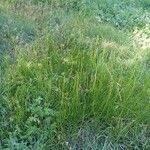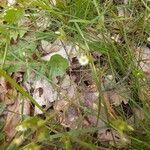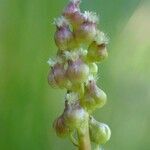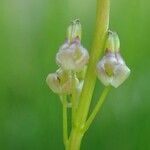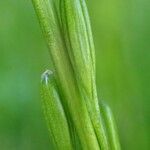Very slender, 2–4 dm; lvs to 3 dm, 1–2 mm wide; raceme 1–2 dm, the very slender pedicels strictly erect; tep 6, 1–1.5 mm; stamens 6; ovaries 3, ovoid, in fr-linear-clavate, 6–9 mm, at maturity parting from the axis from the base upward, remaining attached at the summit, the base very sharply pointed; axis broadly 3-winged, the wings extending between the carpels; 2n=24. Brackish marshes along the coast, and in bogs inland; circumboreal, in Amer. s. to Pa., Ind., Io., Nebr., and N.M. May–July.
Herbs, perennial, ± slender; rhizome short, clothed with sheaths of old leaves. Leaves ca. 20 cm × 1 mm. Scape erect, slender; racemes with ± laxly arranged flowers. Flowers on short pedicels 2(-4) mm, scarcely elongating after anthesis; perianth segments purplish green, elliptic, 2-2.5 mm. Carpels only 3 fertile. Fruit closely appressed to scape, clavate, 6-7(-10) × ca. 1.5 mm, gradually tapering at base, ascending. Fl. and fr. Jun-Oct. 2n = 24, 28.
A delicate herb. It has a bulb like rootstock. It keeps growing from year to year. The branches are short and thread like and come from the bulb. The leaves are 20 cm long by 1 mm wide. The flowers are loosely arranged. The fruit are 6-7 mm long by 1.5 mm wide.
